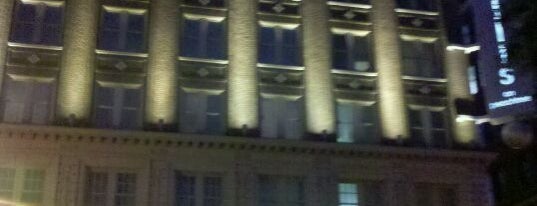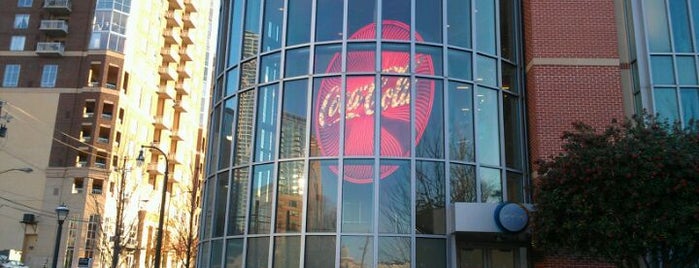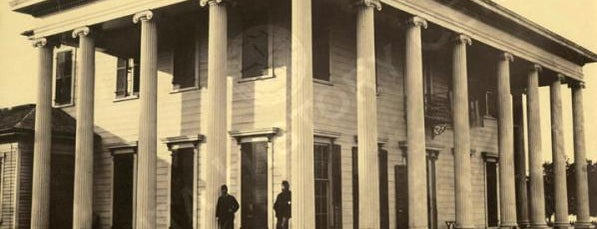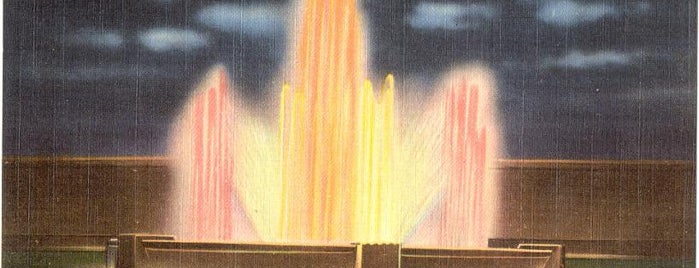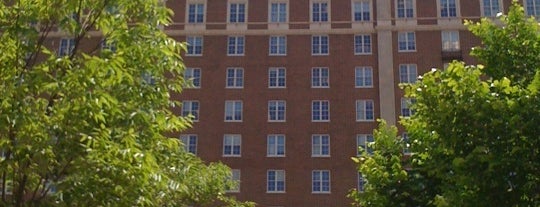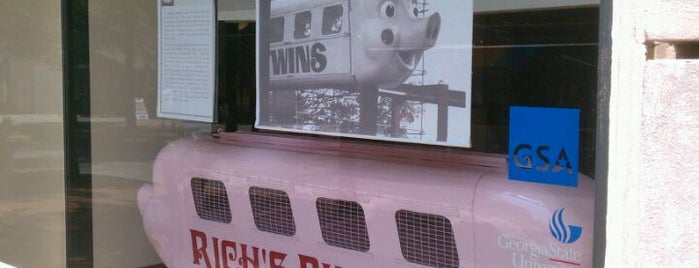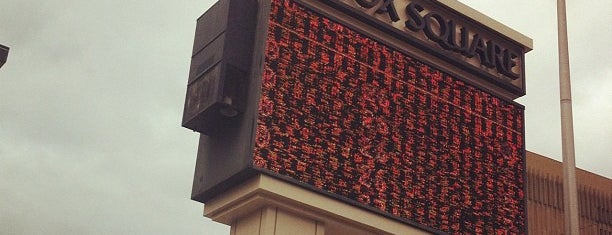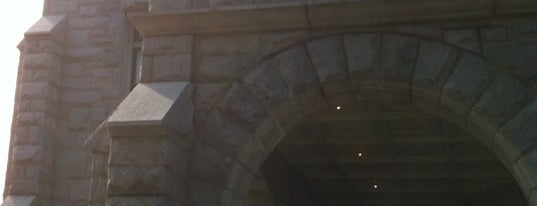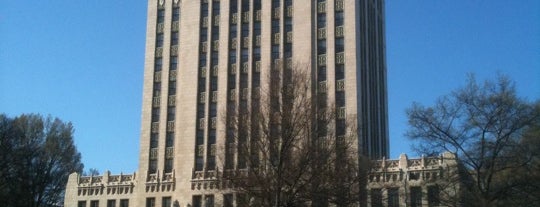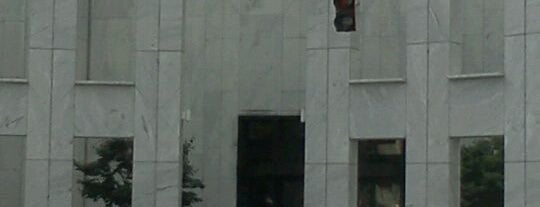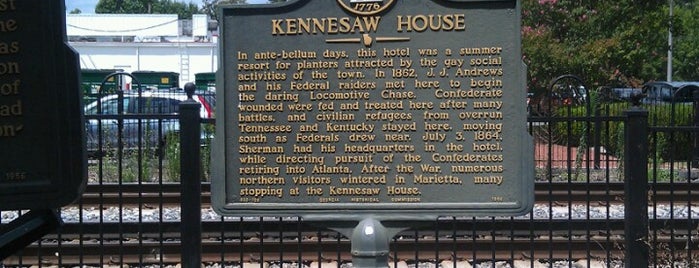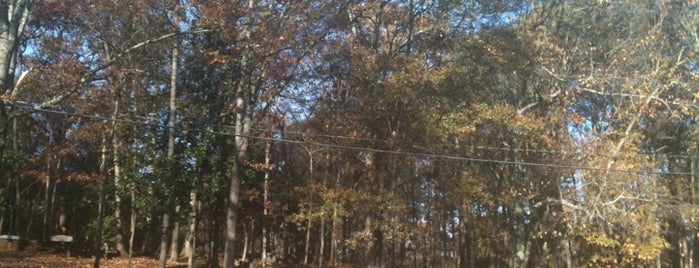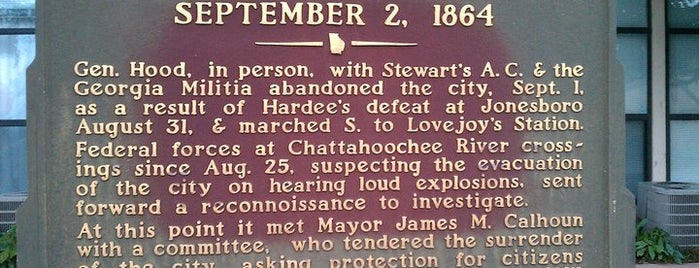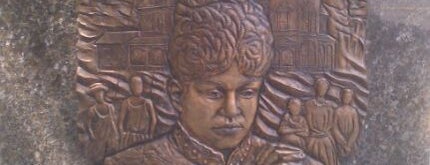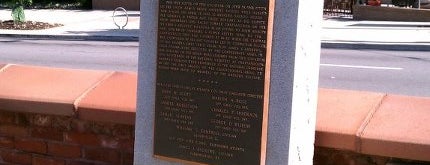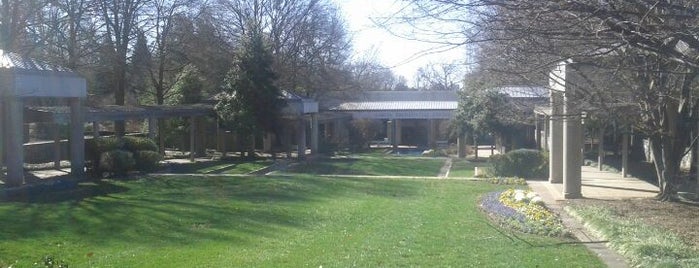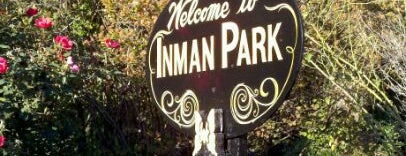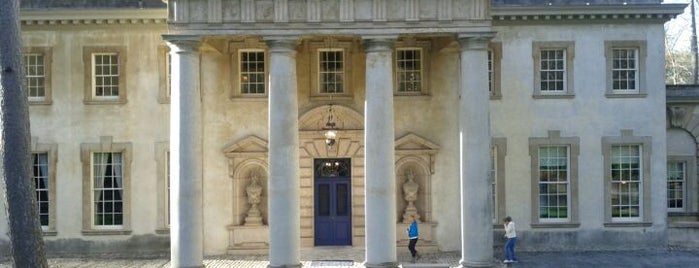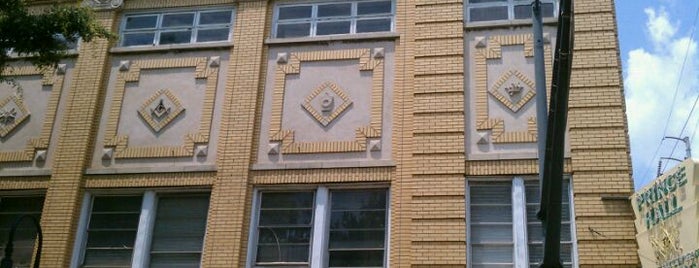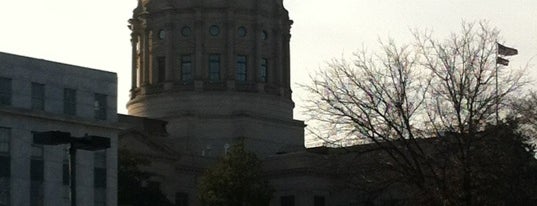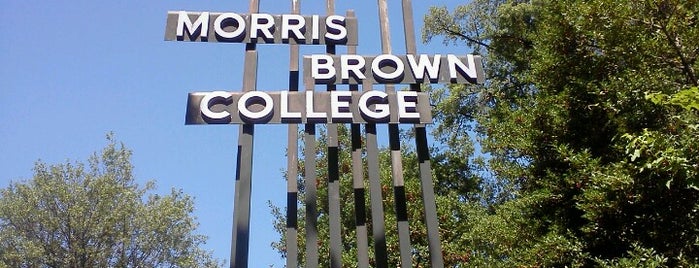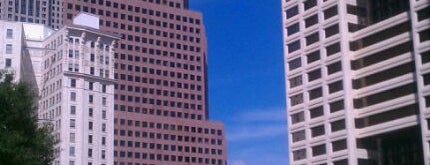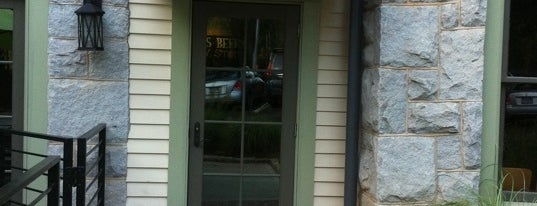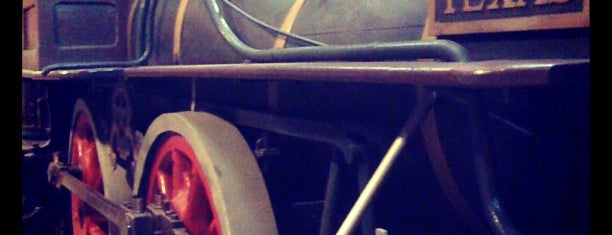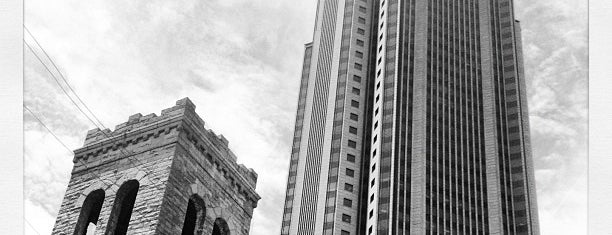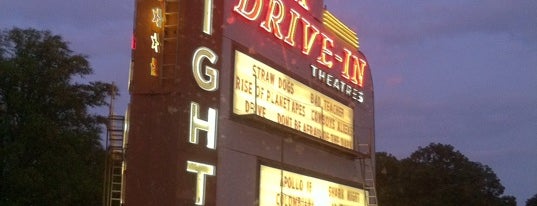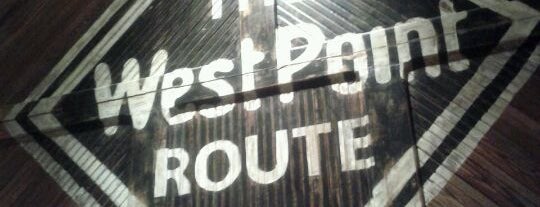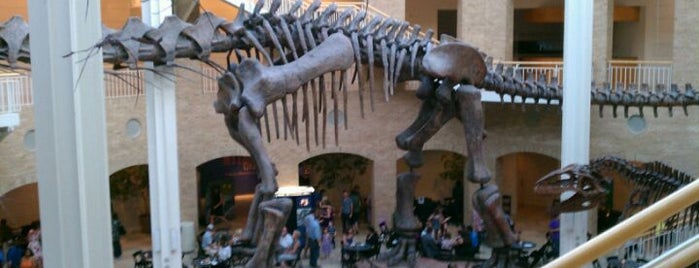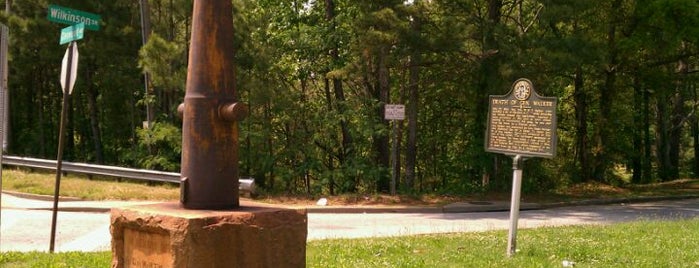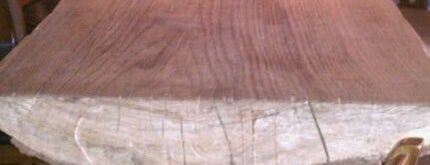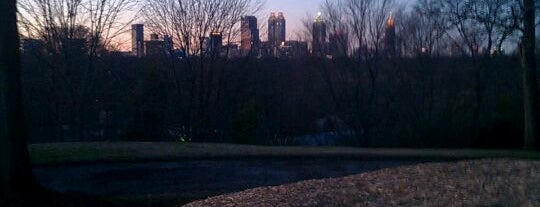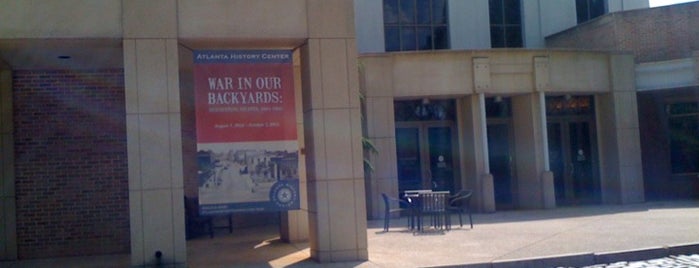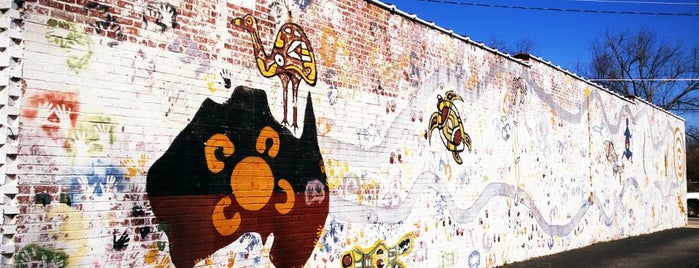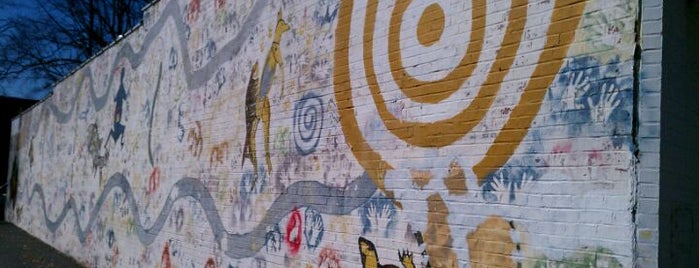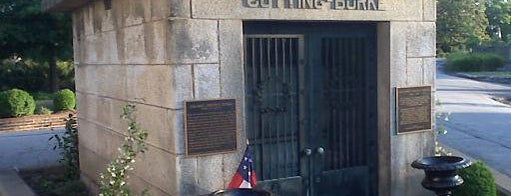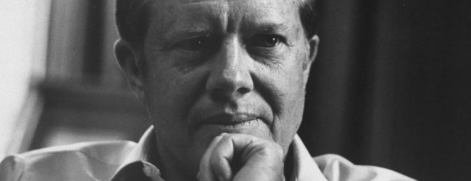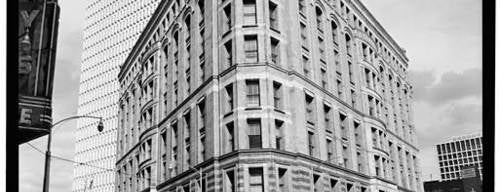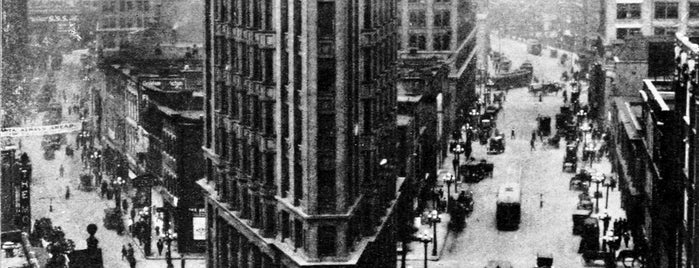![]() In 2003, Atlanta City Council honored former Mayor Jackson by renaming the airport Hartsfield-Jackson. Jackson's work was instrumental in adding the 5th runway making Atlanta the busiest in the world. Read more.
In 2003, Atlanta City Council honored former Mayor Jackson by renaming the airport Hartsfield-Jackson. Jackson's work was instrumental in adding the 5th runway making Atlanta the busiest in the world. Read more.
![]() Atlanta City Brewing Co. operated here at this location from 1876 to 1955 when the brewery was closed & demolished. The underground cellars were destroyed in 1973 when the Hilton Atlanta was built. Read more.
Atlanta City Brewing Co. operated here at this location from 1876 to 1955 when the brewery was closed & demolished. The underground cellars were destroyed in 1973 when the Hilton Atlanta was built. Read more.
![]() The mixing of Pemberton's syrup w/ soda water was created and served out of Jacob's Pharmacy in downtown Atlanta on Peachtree. You can visit Dr. Jacob's mausoleum at Oakland. Read more.
The mixing of Pemberton's syrup w/ soda water was created and served out of Jacob's Pharmacy in downtown Atlanta on Peachtree. You can visit Dr. Jacob's mausoleum at Oakland. Read more.
![]() Across the street stood the Leyden House. When Atlanta was occupied by Union troops, General Thomas used it as his HQ & was where Sherman's March to the Sea was planned. Austin Leyden rests in Oakland Read more.
Across the street stood the Leyden House. When Atlanta was occupied by Union troops, General Thomas used it as his HQ & was where Sherman's March to the Sea was planned. Austin Leyden rests in Oakland Read more.
![]() This park opened in 1940 & is named after banker & real estate developer Joel Hurt (funded by Woodruff Foundation). The fountain originally used 78 bulbs to produce a 20 minute water & light show. Read more.
This park opened in 1940 & is named after banker & real estate developer Joel Hurt (funded by Woodruff Foundation). The fountain originally used 78 bulbs to produce a 20 minute water & light show. Read more.
![]() Nellie Peters Black (Oakland resident) devoted her life to service in the Atlanta community. She was one of the original founders of Grady Hospital and was named a GA Woman of Achievement in 1998. Read more.
Nellie Peters Black (Oakland resident) devoted her life to service in the Atlanta community. She was one of the original founders of Grady Hospital and was named a GA Woman of Achievement in 1998. Read more.
![]() This property was originally where the home of Mary Glover Thurman (Oakland resident) once stood. She was nicknamed " Angel of Atlanta" for her delivering flowers from her personal garden to the sick. Read more.
This property was originally where the home of Mary Glover Thurman (Oakland resident) once stood. She was nicknamed " Angel of Atlanta" for her delivering flowers from her personal garden to the sick. Read more.
![]() Edward C. Peters, son of Richard Peters, built the house in 1883. The Peters family was instrumental in the building of Atlanta both before & after the Civil War. The family is buried in Oakland. Read more.
Edward C. Peters, son of Richard Peters, built the house in 1883. The Peters family was instrumental in the building of Atlanta both before & after the Civil War. The family is buried in Oakland. Read more.
![]() Lenox was the 1st major shopping mall in GA and opened in 1959. Rich's was one of the original anchor stores and was founded by Morris and Emanuel Rich (both Oakland Cemetery residents). Read more.
Lenox was the 1st major shopping mall in GA and opened in 1959. Rich's was one of the original anchor stores and was founded by Morris and Emanuel Rich (both Oakland Cemetery residents). Read more.
![]() Grant Field was named for Hugh Inman Grant, son of John W. Grant, a well-known Atlanta merchant and original benefactor of the stadium. They both reside today in Oakland Cemetery. Read more.
Grant Field was named for Hugh Inman Grant, son of John W. Grant, a well-known Atlanta merchant and original benefactor of the stadium. They both reside today in Oakland Cemetery. Read more.
![]() Bishop W.J. Gaines (Oakland resident) was an early pastor in the church. Born to slave parents, he was a sickly child so he spent most of his time in bed where he taught himself how to read the Bible. Read more.
Bishop W.J. Gaines (Oakland resident) was an early pastor in the church. Born to slave parents, he was a sickly child so he spent most of his time in bed where he taught himself how to read the Bible. Read more.
![]() The Neal family (buried in Oakland) built a home on this property in 1858 which General Sherman took up residency in when he occupied the city in 1864. City Hall was built here in 1930. Read more.
The Neal family (buried in Oakland) built a home on this property in 1858 which General Sherman took up residency in when he occupied the city in 1864. City Hall was built here in 1930. Read more.
![]() On April 11, 1862, "Andrews Raiders" stayed here (Fletcher House then) the night before stealing the train engine The General. Conductor William Fuller (OC resident) led the chase to catch the train. Read more.
On April 11, 1862, "Andrews Raiders" stayed here (Fletcher House then) the night before stealing the train engine The General. Conductor William Fuller (OC resident) led the chase to catch the train. Read more.
![]() One of Dekalb's oldest cemeteries (1830s) w/ approx 1400 residents. Fiddlin' John Carson who is credited as being an early founder of recorded country music is buried here. Read more.
One of Dekalb's oldest cemeteries (1830s) w/ approx 1400 residents. Fiddlin' John Carson who is credited as being an early founder of recorded country music is buried here. Read more.
![]() At this location on Sept 2, 1864, Mayor James Calhoun (Oakland resident) surrendered the City of Atlanta over to Union forces. The city had been under attack since the Battle of Atlanta on July 22nd. Read more.
At this location on Sept 2, 1864, Mayor James Calhoun (Oakland resident) surrendered the City of Atlanta over to Union forces. The city had been under attack since the Battle of Atlanta on July 22nd. Read more.
![]() At the 14th St entrance is a monument commemorating the 'Mission of Peace' to the North in 1879 by the Gate City Guard of ATL led by Col. Joseph Burke (buried in Oakland Cemetery). Read more.
At the 14th St entrance is a monument commemorating the 'Mission of Peace' to the North in 1879 by the Gate City Guard of ATL led by Col. Joseph Burke (buried in Oakland Cemetery). Read more.
![]() 7 members of Andrews Raiders were hung & buried behind this bldg on 6/18/1862 by the Confederate Army for their part in stealing the General (train engine). Marker is across street in Oakland. Read more.
7 members of Andrews Raiders were hung & buried behind this bldg on 6/18/1862 by the Confederate Army for their part in stealing the General (train engine). Marker is across street in Oakland. Read more.
![]() In 1974, Mayor Marynard Jackson (OC resident) refused to sign the paperwork needed to demolish the Fox and on July 10th of that year held the first "Save the Fox" meeting at Herren's restaurant. Read more.
In 1974, Mayor Marynard Jackson (OC resident) refused to sign the paperwork needed to demolish the Fox and on July 10th of that year held the first "Save the Fox" meeting at Herren's restaurant. Read more.
![]() This piece of land used to be the site of the Augustus Hurt Plantation. During the Battle of Atlanta in July 1864, Union General Sherman used the plantation home as his headquarters. Read more.
This piece of land used to be the site of the Augustus Hurt Plantation. During the Battle of Atlanta in July 1864, Union General Sherman used the plantation home as his headquarters. Read more.
![]() Inman Park was Atlanta's 1st planned neighborhood and was designed by Joel Hurt and Sam Inman (Oakland resident). The ATL streetcar was built to take Inman residents from their homes to jobs downtown. Read more.
Inman Park was Atlanta's 1st planned neighborhood and was designed by Joel Hurt and Sam Inman (Oakland resident). The ATL streetcar was built to take Inman residents from their homes to jobs downtown. Read more.
![]() The columns on this building are from the historic Leyden House. It was built in the 1850s at 124 Peachtree St and demolished in 1913. The home served as a Union HQ during the 1864 siege of Atlanta. Read more.
The columns on this building are from the historic Leyden House. It was built in the 1850s at 124 Peachtree St and demolished in 1913. The home served as a Union HQ during the 1864 siege of Atlanta. Read more.
![]() It was built in 1928 for Edward & Emily Inman after their house in Ansley Park burned in 1924. The Inman family resides in Oakland Cemetery. Read more.
It was built in 1928 for Edward & Emily Inman after their house in Ansley Park burned in 1924. The Inman family resides in Oakland Cemetery. Read more.
![]() The statue of John B. Gordon sitting atop a horse is the only equestrian statue at the Capitol. The statue of Joseph E. Brown standing next to his wife is the only female statue on the grounds. Read more.
The statue of John B. Gordon sitting atop a horse is the only equestrian statue at the Capitol. The statue of Joseph E. Brown standing next to his wife is the only female statue on the grounds. Read more.
![]() Wonderful place to learn about the history of Atlanta's Jewish population. Be sure to check out our tours at Oakland focusing on Jewish residents buried here & one on the Leo Frank case. Read more.
Wonderful place to learn about the history of Atlanta's Jewish population. Be sure to check out our tours at Oakland focusing on Jewish residents buried here & one on the Leo Frank case. Read more.
![]() Union spy James Andrews was executed near this spot in 6/7/1862. He was the leader of Andrews Raiders who stole a train engine called The General. This event is known as "The Great Locomotive Chase". Read more.
Union spy James Andrews was executed near this spot in 6/7/1862. He was the leader of Andrews Raiders who stole a train engine called The General. This event is known as "The Great Locomotive Chase". Read more.
![]() One of the founders of the college was Bishop Wesley John Gaines who was an early pastor at Big Bethel AME Church. You can visit the final resting place of Bishop Gaines inside Oakland Cemetery. Read more.
One of the founders of the college was Bishop Wesley John Gaines who was an early pastor at Big Bethel AME Church. You can visit the final resting place of Bishop Gaines inside Oakland Cemetery. Read more.
![]() Disney's Song of the South had its world premiere at the Fox Theatre in 1946. Joel's son Julian (& his wife Julia), pulitzer prize winning journalists, reside in the Rawson mausoleum at Oakland. Read more.
Disney's Song of the South had its world premiere at the Fox Theatre in 1946. Joel's son Julian (& his wife Julia), pulitzer prize winning journalists, reside in the Rawson mausoleum at Oakland. Read more.
![]() Originally constructed as a residence by Victor Hugo Kriegshaber who owned several building material supply businesses. The architect also designed Rhodes Hall in Midtown. Victor rests in Oakland. Read more.
Originally constructed as a residence by Victor Hugo Kriegshaber who owned several building material supply businesses. The architect also designed Rhodes Hall in Midtown. Victor rests in Oakland. Read more.
![]() Plaza opened its doors in 1939 & is the oldest continuously operated cinema in Atlanta. A non-profit Foundation was created to restore the theatre, promote independent film, & support the local arts. Read more.
Plaza opened its doors in 1939 & is the oldest continuously operated cinema in Atlanta. A non-profit Foundation was created to restore the theatre, promote independent film, & support the local arts. Read more.
![]() Inside the museum is "The Texas" which Capt William Fuller used to recapture "The General" from Andrews Raiders. Capt Fuller is buried in Oakland Cemetery. Read more.
Inside the museum is "The Texas" which Capt William Fuller used to recapture "The General" from Andrews Raiders. Capt Fuller is buried in Oakland Cemetery. Read more.
![]() The granite used to build the church was donated by Sam Venable, past owner of Stone Mountain. The first service of worship in the new building was held on Thanksgiving Day, 1900. He rests in Oakland. Read more.
The granite used to build the church was donated by Sam Venable, past owner of Stone Mountain. The first service of worship in the new building was held on Thanksgiving Day, 1900. He rests in Oakland. Read more.
![]() The mill complex dates back to the 1880s when it was founded by Jacob Elsas. It closed operations in 1978 and was vacant until residence conversion began in 1999. Visit the Elsas mausoleum in Oakland. Read more.
The mill complex dates back to the 1880s when it was founded by Jacob Elsas. It closed operations in 1978 and was vacant until residence conversion began in 1999. Visit the Elsas mausoleum in Oakland. Read more.
![]() After you see the The General, visit Oakland Cemetery in Atlanta to visit the final resting place of its Engineer Capt. William Fuller and see the spot where some of the Andrews' Raiders were hung. Read more.
After you see the The General, visit Oakland Cemetery in Atlanta to visit the final resting place of its Engineer Capt. William Fuller and see the spot where some of the Andrews' Raiders were hung. Read more.
![]() Fort Walker was located in the SE corner of the park. It was named after CSA General W.H.T. Walker who was killed during the Battle of Atlanta on July 22, 1864. Read more.
Fort Walker was located in the SE corner of the park. It was named after CSA General W.H.T. Walker who was killed during the Battle of Atlanta on July 22, 1864. Read more.
![]() The 1st Atlanta home of Oglethorpe was in a house built in 1858 by the Neal family (buried in Oakland). The house was eventually torn down in 1930 and Atlanta City Hall sits on the property today. Read more.
The 1st Atlanta home of Oglethorpe was in a house built in 1858 by the Neal family (buried in Oakland). The house was eventually torn down in 1930 and Atlanta City Hall sits on the property today. Read more.
![]() Thank you for visiting with us today. Please stop by the gift shop located in the Bell Tower while you are here for more information on tours and a great selection of books & gifts. Read more.
Thank you for visiting with us today. Please stop by the gift shop located in the Bell Tower while you are here for more information on tours and a great selection of books & gifts. Read more.
![]() The CSA lost a great General on this spot in July 22nd. Fort Walker in the SE corner of Grant Park was named in his honor. General Hugh Mercer took command of Walker's troops after his death. Read more.
The CSA lost a great General on this spot in July 22nd. Fort Walker in the SE corner of Grant Park was named in his honor. General Hugh Mercer took command of Walker's troops after his death. Read more.
![]() Located near East Atlanta Village, this large cannon monument marks the place where the highest ranking army commander in the Civil War was killed: Union Major General James Birdseye McPherson. Read more.
Located near East Atlanta Village, this large cannon monument marks the place where the highest ranking army commander in the Civil War was killed: Union Major General James Birdseye McPherson. Read more.
![]() Inside the Civil War exhibit you will find the diary of Carrie Berry. Written when she was just 10 years old, it details her experiences during the Battle of Atlanta. She resides in Oakland Cemetery. Read more.
Inside the Civil War exhibit you will find the diary of Carrie Berry. Written when she was just 10 years old, it details her experiences during the Battle of Atlanta. She resides in Oakland Cemetery. Read more.
![]() Australian artist Pamela Croft painted the 20x100 ft mural on the EAAC building in 2004. "Bringing Nations Cultures & Communities Together" is one of the largest pieces of Aboriginal art in the world. Read more.
Australian artist Pamela Croft painted the 20x100 ft mural on the EAAC building in 2004. "Bringing Nations Cultures & Communities Together" is one of the largest pieces of Aboriginal art in the world. Read more.
![]() Approx 24 Confederate troops are buried here. Look for the unknown soldier marker that reads: “Confederate soldier, unknown to fame, died for his country all the same. Rest soldier thy warfare.” Read more.
Approx 24 Confederate troops are buried here. Look for the unknown soldier marker that reads: “Confederate soldier, unknown to fame, died for his country all the same. Rest soldier thy warfare.” Read more.
![]() Australian artist Pamela Croft painted the 20x100 ft mural on the building & is titled "Bringing Nations, Cultures & Communities Together". It is one of the largest ex of Aboriginal art in the world. Read more.
Australian artist Pamela Croft painted the 20x100 ft mural on the building & is titled "Bringing Nations, Cultures & Communities Together". It is one of the largest ex of Aboriginal art in the world. Read more.
![]() Constructed in 1891, it served as the HQ of the Dixie Coca-Cola Bottling Co. The basement housed the syrup production factory with offices located upstairs. It is the oldest surviving "Coke" building. Read more.
Constructed in 1891, it served as the HQ of the Dixie Coca-Cola Bottling Co. The basement housed the syrup production factory with offices located upstairs. It is the oldest surviving "Coke" building. Read more.
![]() The school was named after William A. Bass when it opened in 1923. A graduate of Emory College, Professor Bass was one of the most well known educators of youth in Atlanta. Today, he rests in Oakland. Read more.
The school was named after William A. Bass when it opened in 1923. A graduate of Emory College, Professor Bass was one of the most well known educators of youth in Atlanta. Today, he rests in Oakland. Read more.
![]() Alexander Stephens was briefly interred inside Oakland. The Governor's body was carried to the cemetery after lying in state at the Capitol. 20,000 people lined the streets & attended the funeral. Read more.
Alexander Stephens was briefly interred inside Oakland. The Governor's body was carried to the cemetery after lying in state at the Capitol. 20,000 people lined the streets & attended the funeral. Read more.
![]() Popular spot to watch political debates & election results w/ historic roots in politics. Jimmy Carter announced his 1970 bid for GA Governor here & original owner Manny was the 1st CEO of Dekalb Co. Read more.
Popular spot to watch political debates & election results w/ historic roots in politics. Jimmy Carter announced his 1970 bid for GA Governor here & original owner Manny was the 1st CEO of Dekalb Co. Read more.
![]() Atlanta's first skyscraper, Equitable Building, once stood here. It was erected in 1892 with 8 stories & demolished in 1971 - built for real estate developer Joel Hurt who rests in Oakland today. Read more.
Atlanta's first skyscraper, Equitable Building, once stood here. It was erected in 1892 with 8 stories & demolished in 1971 - built for real estate developer Joel Hurt who rests in Oakland today. Read more.
![]() The Flatiron (completed in 1897) was the 2nd skyscraper built in Atlanta & is the oldest remaining. The first in our city was the Equitable building which was erected in 1892, but demolished in 1971. Read more.
The Flatiron (completed in 1897) was the 2nd skyscraper built in Atlanta & is the oldest remaining. The first in our city was the Equitable building which was erected in 1892, but demolished in 1971. Read more.
![]() One of several Atlanta locations of Jacobs' Pharmacy once occupied this building. Coca-Cola was first sold on May 8, 1886 at the Peachtree & Marietta St store. Dr Joseph Jacobs rests today in Oakland. Read more.
One of several Atlanta locations of Jacobs' Pharmacy once occupied this building. Coca-Cola was first sold on May 8, 1886 at the Peachtree & Marietta St store. Dr Joseph Jacobs rests today in Oakland. Read more.
![]() The SW corner of the Peachtree & Marietta St intersection stood Jacobs' Pharmacy. On May 8, 1886, the first Coca-Cola fountain drink was sold here for only 5 cents. Dr Joseph Jacobs rests in Oakland. Read more.
The SW corner of the Peachtree & Marietta St intersection stood Jacobs' Pharmacy. On May 8, 1886, the first Coca-Cola fountain drink was sold here for only 5 cents. Dr Joseph Jacobs rests in Oakland. Read more.



